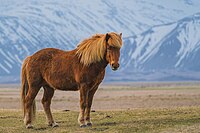
Photo from wikipedia
The hamburger has been targeted for substitution by numerous plant-based alternatives. However, many consumers find the taste of these alternatives lacking, and thus we proposed a hybrid meat and plant-based… Click to show full abstract
The hamburger has been targeted for substitution by numerous plant-based alternatives. However, many consumers find the taste of these alternatives lacking, and thus we proposed a hybrid meat and plant-based burger as a more acceptable alternative for these consumers. The burger was made from 50% meat (beef and pork, 4:1) and 50% plant-based ingredients, including texturised legume protein. Texture and sensory properties were evaluated instrumentally and through a consumer survey (n = 381) using the check-all-that-apply (CATA) method. Expressible moisture measurements indicated a significantly juicier eating experience for the hybrid compared to a beef burger (33.5% vs. 22.3%), which was supported by the CATA survey where “juicy” was used more to describe the hybrid than the beef burger (53% vs. 12%). Texture profile analysis showed the hybrid burger was significantly softer (Young’s modulus: 332 ± 34 vs. 679 ± 80 kPa) and less cohesive than a beef burger (Ratio 0.48 ± 0.02 vs. 0.58 ± 0.01). Despite having different textural and CATA profiles, overall liking of the hybrid burger and a beef burger were not significantly different. Penalty analysis indicated that “meat flavour”, “juiciness”, “spiciness” and “saltiness” were the most important attributes for a burger. In conclusion, the hybrid burger had different attributes and was described with different CATA terms than a beef burger but had the same overall acceptability.
Journal Title: Foods
Year Published: 2023
Link to full text (if available)
Share on Social Media: Sign Up to like & get
recommendations!